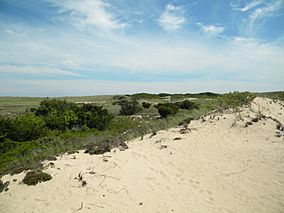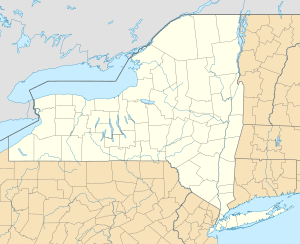Amagansett National Wildlife Refuge facts for kids
Quick facts for kids Amagansett National Wildlife Refuge |
|
|---|---|
|
IUCN Category IV (Habitat/Species Management Area)
|
|

Dunes at Amagansett National Wildlife Refuge
|
|
| Location | Suffolk County, New York, United States |
| Nearest city | Amagansett, New York |
| Area | 36 acres (15 ha) |
| Established | 1968 |
| Governing body | U.S. Fish and Wildlife Service |
| Website | Amagansett National Wildlife Refuge |
The Amagansett National Wildlife Refuge is a special protected area in Amagansett, New York. It is located right along the shore of the Atlantic Ocean on the eastern part of Long Island. This refuge is managed by the United States Fish and Wildlife Service, which helps protect nature across the country. It is part of the larger Long Island National Wildlife Refuge Complex.
Contents
Discover Amagansett National Wildlife Refuge
The Amagansett National Wildlife Refuge was created on December 16, 1968. It covers about 36 acres of land. This refuge is very important for protecting delicate shore habitats and the animals that live there.
Why is This Refuge Special?
A main goal of the refuge is to protect the secondary dunes. These sand dunes are becoming rare on Long Island because of new buildings and homes. The refuge has a special double dune system. This includes the sandy beach, the first set of dunes, and then the secondary dunes.
The area also has different types of land. You can find wet dips called swales, grassy wetlands known as fens, and wet, acidic areas called cranberry bogs. There are also areas with small oak trees called oak scrub. Many unusual plants grow here, including several kinds of orchids.
Who Lives at Amagansett?
The refuge is home to many different animals throughout the year.
Birds of the Refuge
- In winter, birds like Long-tailed ducks, white-winged scoters, common loons, and horned grebes spend their time off the refuge shore.
- During spring and fall, many shorebirds, songbirds, and raptors (birds of prey) visit.
- Birds of prey like Merlins, Cooper's hawks, kestrels, sharp-shinned hawks, and peregrine falcons fly over the dunes during their long migrations.
- Some birds, such as the Ipswich sparrow, rough-legged hawk, and short-eared owl, stay at the refuge for the winter.
- In late spring and summer, the beach is a nesting spot for piping plovers, common terns, and least terns. These terns are protected by the Endangered Species Act, which helps save animals that are at risk. Other shorebirds like sandpipers also use the beach.
Other Animals
The eastern hognose snake can still be found at the refuge. This snake is a special concern species in New York State, meaning it needs protection to keep its population healthy.



